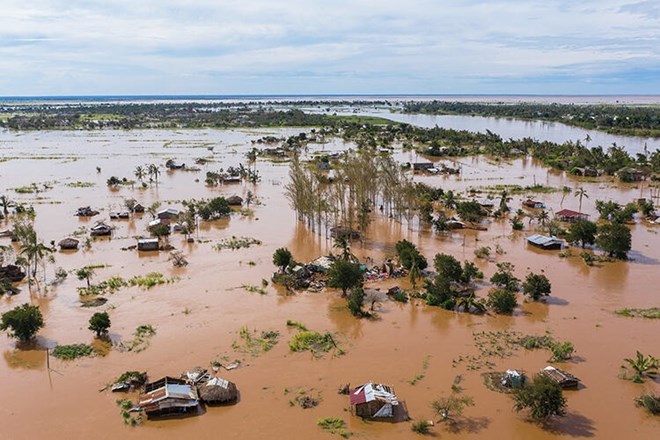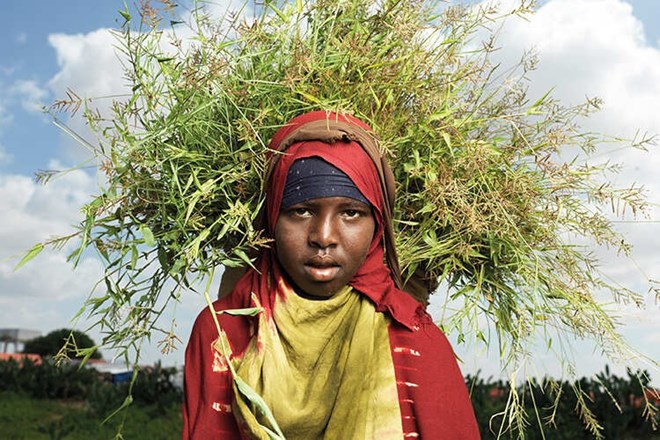
Thursday July 25, 2024
By Freddie Clayton
After an unprecedented year of extreme weather, El Niño has come to an end. For millions in East Africa, however, the future remains uncertain

A flooded village in Mozambique. Image: Shutterstock
Between 2021 and early 2023, Somalia suffered through the longest-recorded drought in its history. Crops and cattle perished, pushing the nation to the brink of famine and killing at least 43,000 people, while displacing more than 1.5 million more. Then came the floods.
Samsam Muxumed Hussein had already lost her livestock and crops to drought when the floods washed through her land on the outskirts of Beledweyne, the capital of the Hiraan Region in central Somalia. ‘We had not recovered from the drought and now the floods have displaced us,’ says Hussein, who now lives in one of Somalia’s 2,000 internally displaced persons (IDP) camps. She fears for the future of her nine children. ‘Sometimes we get food for one meal. Everyone is trying to take care of their children and family while looking for jobs, but in this new place there is nothing to find.’
Like Somalia, Malawi also experienced the crippling effects of both heavy rains and scorching drought last year. In March 2023, at harvest time, the strongest and longest-lasting tropical cyclone ever recorded – Cyclone Freddy – dropped six months’ worth of rainfall on southern Malawi in six days, triggering floods and mudslides that killed more than 1,200 people. More than two million farmers lost their crops and 1.4 million livestock either starved or were lost or drowned. People Serving Girls at Risk, a Malawian organisation working to protect young women and girls from sexual exploitation, reported a three-fold increase in requests for its counselling services as women were forced into sex work after their farms were destroyed.
Then, as Malawians returned to their farms in November, an El Niño-driven drought led to the region’s worst mid-season dry spell in more than 100 years. Temperatures soared to 5°C above average, causing blistering heatwaves when the rains were supposed to fall.
While back-to-back climate shocks may seem like a freak occurrence, other nations in the region have similarly suffered the compounding impacts of recurring disasters in recent years. In Zambia, heavy rainfall and floods led to the worst outbreak of cholera in the nation’s history in 2023, killing more than 700 people, before this year’s drought left 6.6 million in need of humanitarian assistance. At least 155 people died in floods and landslides in Tanzania in heavy rains caused by El Niño, just one year after a prolonged drought. In 2019, for the first time in recorded history, two strong tropical cyclones hit Mozambique in the same season. Last year, Cyclone Freddy struck the nation, leaving 198 people dead before 10,000 homes were destroyed this year by tropical storm Filipo. ‘We don’t have enough time to conclude one assessment and get our heads around a response, and start mobilising, before another shock arrives,’ says Antonella D’Aprile of the World Food Programme.

A refugee from the extensive flooding in Somalia. Image: Peter Caton
This May marked the 12th consecutive month of record-breaking global temperatures, fuelled in part – according to the Copernicus Climate Change Service – by El Niño, a naturally occurring event that brings unusually warm waters to the eastern Pacific Ocean and disrupts weather patterns around the world. According to a World Weather Attribution study, the climate phenomenon, which finally ended in April as the eastern Pacific cooled, has been a key driver behind eastern Africa’s record-breaking drought. However, with the emergence of La Niña – El Niño’s counterpart pattern – and the ongoing impacts of climate change, there will be little reprieve for the region.
In 2021, the Intergovernmental Panel on Climate Change’s (IPCC) sixth assessment report projected that extreme weather events were set to become more frequent. This includes more heavy-rainfall events in East Africa, with more frequent, longer and intense droughts in Somalia. The same report projects a decrease in mean precipitation in southeastern Africa, alongside increasing droughts, extreme precipitation and more intense cyclones. Recent studies have also found that climate change was likely increasing the ferocity of El Niño events, as well as the intensity of its cooling La Niña phase. A 2023 study, led by scientists at Australia’s CSIRO agency, said that the strength of these events may have increased by about ten per cent.
Even if El Niño events stay the same, says Richard Allan, a professor of climate science at the University of Reading, climate change can amplify their impacts. ‘A warmer, thirstier atmosphere is more effective at sapping moisture from one region and feeding this excess water into storms elsewhere. During El Niño, when wind patterns are forced out of kilter by the natural and temporary warming across a vast area of the eastern Pacific Ocean, human-caused warming of climate is supercharging the unusual hot, dry or wet weather extremes experienced across multiple regions of the planet.’
